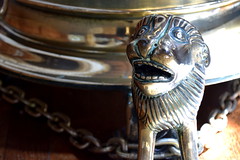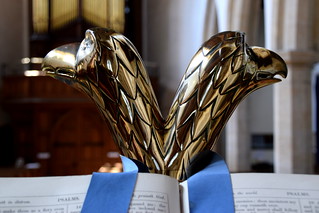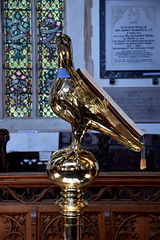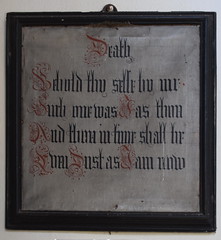| |
|
St Mary,
Redenhall
 |
|
I
had not been back to Redenhall for ten years, but
its great tower is unforgettable, rearing out of
the rolling hills to the north of the Waveney. As
you get closer, you see that spreading beyond the
church is what must be one of the largest
churchyards in Norfolk, and there is a reason for
this. Although Redenhall is a tiny village, the
parish includes the pretty market town of
Harleston, from which it is separated by the
horrible Diss to Yarmouth road. Harleston has a
19th century chapel of ease in its centre, but
when you see St Mary even from a distance you
know that this is the one that means business.
Reminiscent of the towers at Eye and Laxfield
over the Suffolk border, the tower was almost
certainly the work of the same masons. It was
bankrolled by the De la Poles, one of the richest
families in East Anglia in the 15th century, and
the fact that the elaborate flushwork is only in
three sides of the tower, but not on the south
side which cannot be seen from the road, shows
that they were a pretty wily bunch when it came
to splashing the cash.
|
The De la
Poles had been beneficiaries of the pestilences of the
previous century, when the deaths of roughly half the
people of Norfolk and Suffolk resulted in the break-up of
the old estates and the rising of wages and prices,
enabling those with money to buy land cheaply. This
emergence across northern Europe of a property-owning
independent middle class without historic ties and
loyalties to their parishes and people would inevitably
lead to the continent's two great ideologies of the
second half of the millennium, Protestantism and
Capitalism.
But that
was in the future when the De la Poles and fellow
proto-capitalists the Brothertons were making bequests to
rebuild St Mary. Up went the tower and the clerestory,
and the aisle windows were all replaced in the fashion of
the day. Only the chancel was left looking rather mean
and slight. Perhaps they would have got to that too had
priorities not changed. Around the base of the tower you
can see their leopard and wild man symbols. You might
also spot tortoises, for this was the symbol of the Gawdy
family. One curious detail is the carving of farriers'
implements on the west door. These have been taken to
mean that the door was paid for by the local farriers'
guild, but I see no reason to suppose that the carving is
contemporary, and I think it is as likely to be the work
of an idle 18th century hand.
Redenhall church is famous for one particular medieval
survival. This is the spectacular double-headed eagle
lectern, the glorious product of a 15th century East
Anglian workshop. There is another in one of the Kings
Lynn churches, and the one at St Mark's in Venice is said
to be from the same workshop. I love the little lions on
the pedestals best of all. Remarkably, the church has a
second medieval lectern, a wooden one, and both are
solidly chained down to prevent theft.
  
Inevitably,
the interior of the church is not going to live up to the
exterior. Today, I had come here from the two churches of
the Pulhams, both huge barns of churches, and this one is
a bit of a barn too, vast and echoey, but perhaps a
classier barn than the two I had previously visited. It
is true that the inside of St Mary has been thoroughly
Victorianised, and it is really hard to summon up any
sense of its medieval life. The serious dark woodwork of
the case of the Holdich organ in the west gallery would
have frowned on the acres of coloured glass in the naves
at the Pulhams, but here there is relatively clear light
with only a few Ward & Nixon windows that can easily
be tuned out. The best glass is in the chancel, the early
20th Century east window by Herbert Bryans to the design
of Ernest Heasman. They worked together elsewhere in
Norfolk in the north transept at Salle, and on the east
window at Holt which is broadly similar to this one. The
other glass in the chancel is of the 1860s, by Thomas
Baillie.
There are
interesting corners which give the church very much a
character of its own, for example the Gawdy chapel at the
east end of the north aisle which contains a spirited
classical altar tomb of the late 18th century, a hint of
Strawberry Hill Gothick about it, rather unusual but very
well done.
The
window of heraldic glass is by Samuel Yarrington,
and is said to have come from Gawdy Hall in the
north of the parish, demolished in the early
years of WWII. An intriguing detail in the Gawdy
chapel is a 16th Century Venetian linen chest
which is also said to come from Gawdy Hall. It
stands open, and you can see a depiction of the
Annunciation with sailing ships above on the
inside of the lid, which is at once very curious
and rather lovely.
You can walk around the great organ to beneath
the tower, an impressive space as large as some
churches. Though the west doorway is no longer in
use, you get an impression of the great
processional entrance this must once have been,
and perhaps an inkling of what St Mary was like
in its late medieval heyday, a place at last to
reflect on the glory that once was here. As if to
remind us of the passing of all such things, a
surviving painted plaque, probably from a lost
17th Century memorial, hangs beside the tower
arch. Death, it reads, behold thy
selfe to me, such one was I as thou, and thou in
time shall be even dust as I am now...
|
|
 |
Simon Knott, August 2018
|
|
|
